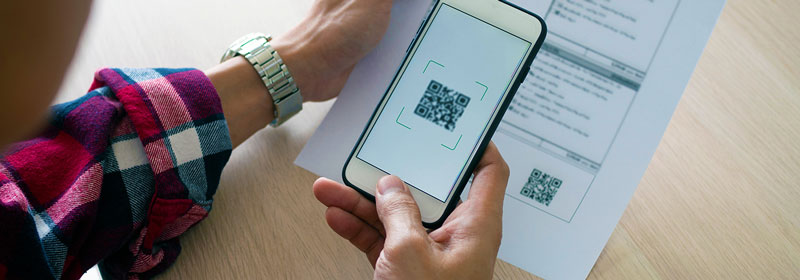What is a QR Code?
A QR code is a machine readable code that is made up of a collection of black and white squares. It usually stores URLs and when users scan it with their smartphone it leads them to a selected URL.
QR codes made a comeback in recent years when COVID-19 hit. Many restaurants switched to QR codes instead of having menus out, businesses adapted and used QR codes to take payments, and many other ways to minimize contact. As people became familiar with using them we’ve started to see them appear more and more in marketing. From local use on menus, national companies using them on point of sales materials, and even on a Super Bowl commercial back in 2022!

Do's:
1. Get creative with your QR Code – Many QR code generator tools allow for customizations like brand colors or logos to be incorporated into the QR code. Just make sure they are still easy to read and scan
2. Use QR Codes with Traditional Media:
- Print materials are the perfect place for QR codes! This allows for customers to receive print materials regarding a business while also having an easy way to access their online presence. A few of our favorite uses are on business cards, invoices, or sales materials. It’s an easy way to send customers to your website, social media pages, or a review page.
- TV Commercials can be another great spot for QR codes. This allows a brand’s message to get across to viewers and give them an easy way to get directly to the website.
- Point of purchase materials are another great way to easily send customers to a business’ website, social media, or review page. They also have a higher chance of being scanned given they are being seen by someone already in your business.
3. Keep Track of Your QR Codes – Make sure to keep track of what QR codes are created and make any updates if website URLs change. Many QR code generation programs also allow you to track scans when you create your code. It’s also a good idea to test any QR codes you create before using them in marketing materials.
Don'ts:
1. QR Codes on Social Media – Social media platforms allow links in their posts or the profile’s bio to help drive followers to the website. Using QR codes on social media is unnecessary. In addition, a good majority of social media posts are looked at on mobile phones which is the device people would use to scan your code.
2. QR Codes on Banner Ads – QR codes do not belong on digital banner ads. Similar to social media, they are not needed here. The goal with these targeted digital ads is to get users to click on them and go to a website. Additionally, these ads are typically created in a wide range of sizes with some of them being very small. QR codes take up an already limited space when we can send people directly to your website with a click on the ad.
3. No Call to Action With Your QR Code – Just like digital ads, a call to action is important to include with a QR code. Tell people to scan, what they’re scanning, and why!
QR codes can be a great way to help traditional and digital marketing tactics work together. Next time you’re visiting with an advertiser or reviewing your own marketing strategies look at QR code use. Are QR codes being used? If so, are they being used correctly and in a way that’s beneficial? If you would like to learn more about adding QR codes into your marketing strategies contact our team today!